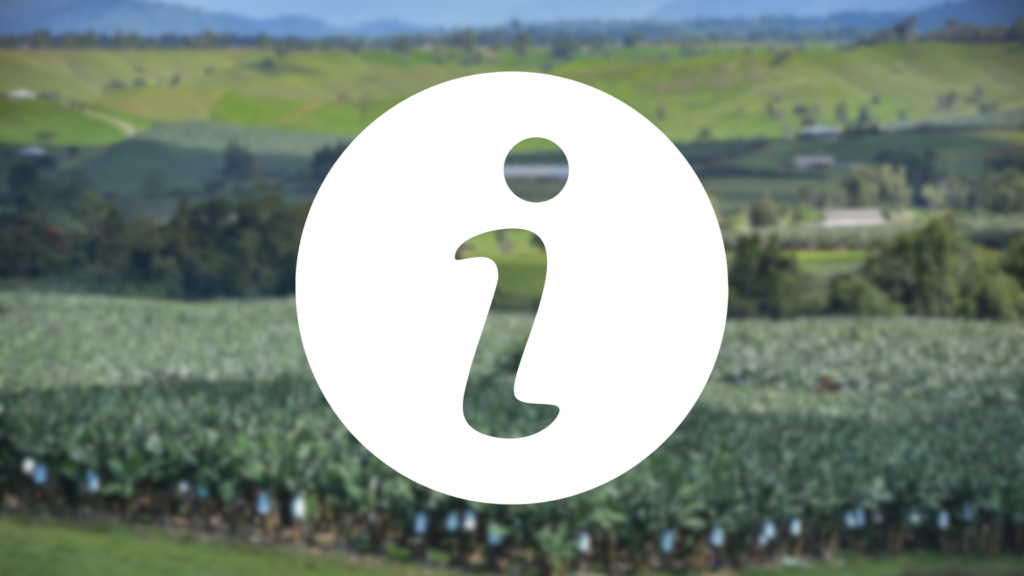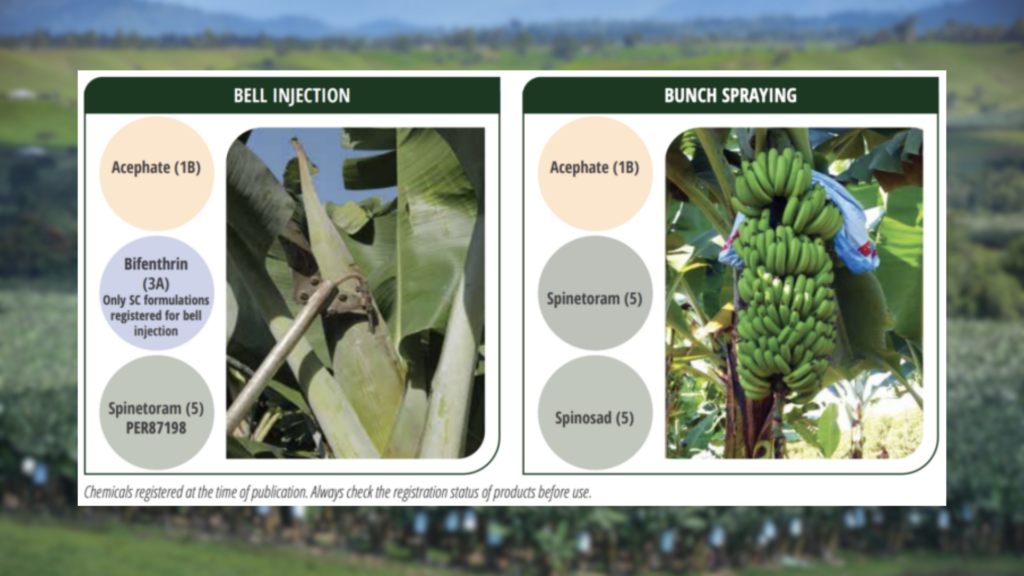Chlorpyrifos Information
What you need to know




The Australian Pesticides and Veterinary Medicines Authority (APVMA) has released its regulatory decision on chlorpyrifos, cancelling all uses (eg Strikeout 500 plus many other products) in bananas.
What you need to know
- All uses of chlorpyrifos in bananas have now been cancelled.
- A 12 month phase out period aimed to allow product users to use the product already in the supply chain or on farm but does not allow manufacture or import.
- APVMA cites worker health and safety concerns as well as environmental impacts as the reasons for the cancellation.
- The cancellation affects a number of horticultural industries.
Where you can get more information on the APVMA decision
What’s happened to get to this point
- Chlorpyrifos was nominated for reconsideration in 1994 due to possible risks associated with work health and safety, residues in food and to the environment.
- A number of reports and assessments were published in the years that followed resulting in adjustments to regulations.
- APVMA cancelled all home garden and domestic uses of chlorpyrifos in 2019, as well as the registrations for products with only those uses on the label.
- A number of countries have already withdrawn the use of chlorpyrifos for crops, including in the US, Canada and the European Union.
- Public consultation for this APVMA decision was open until March 2024. You can read the ABGC’s submission here.
- This latest regulatory decision means most urban and agricultural uses of chlorpyrifos have been cancelled in Australia.
Resources

APVMA review page

Preparing to manage bunch pests without chlorpyrifos – article from Tegan Cavallaro, Ingrid Jenkins & Sarah Williams (DAF).

Dr Rosie Godwin, ABGC’s R&D Manager, hosted a webinar on the chlorpyrifos review in December 2023.
Key Dates

Timeline last updated 4 October 2024
What has industry done about this?
- The ABGC has highlighted the impact the cancellation of chlorpyrifos would have on the banana industry to Hort Innovation who have secured funding for the inclusion of a new active constituent in trials. These trials will gather data for potential registration in bananas for bunch pests. These trials won’t be completed before 2026.
- ABGC has coordinated a submission to APVMA on the impact the loss of chlorpyrifos would have on the banana industry if it is withdrawn from use.
ABGC submission conclusion:
Chlorpyrifos is an important chemical used widely by the banana industry for targeted control of bunch pests. The options for banana growers are becoming increasingly limited as actives come under review and are lost to industry. Chlorpyrifos is considered to be an effective chemical, easy to use and less hazardous to workers and the environment, and it is important to retain its use to help manage pest populations and prevent build-up of resistance.
- New methods of bunch pest control, including softer options and biologicals, are being researched in the 5-year Banana Integrated Pest and Disease Management Program being delivered by the Department of Agriculture and Fisheries (DAF) and funded through the Hort Innovation banana fund (R&D levy).
- As part of the National Banana Development & Extension Project, bunch pest management was raised as a priority issue for growers. As a result, a series of field trials have been undertaken to better understand how to effectively manage bunch pests with the current chemistries registered for control of bunch pests.
- Relevant information is being delivered to growers through the National Banana Development and Extension Project and Banana Industry Communication Program.
⇒⇒Key communications and updates:
- May 2022: Update on regulatory action on crop protection chemicals (Australian Bananas magazine)
- June 2022: Far North QLD Roadshows (review discussed)
- July 2022: Permit extended pending review (e-bulletin)
- August 2022: Chlorpyrifos review – what you need to know (Australian Bananas magazine, page 9)
- December 2022: Extension project focussed on bunch pest management (Australian Bananas magazine, page 19)
- May 2023: Regulatory decision delayed (e-bulletin)
- 29 September, 2023: e-bulletin announcing the halt in production of Strike-outWP
- 12 December, 2023: Update and opportunity to attend webinar
- 18 December, 2023: E-bulletin update
- December 2023: Chlorpyrifos countdown (Australian Bananas magazine, page 20-21)
- 8 March 2024: ABGC submission to APVMA
- April 2024: Controlling bunch pests without chlorpyrifos (Australian Bananas magazine, page 20-21)
- 24 May, 2024: One-year permit extension pending review (e-bulletin)
- June 2024: Bunch spray forum at South Johnstone research station
- August 2024: Australian Bananas magazine published, Banana Roadshows (organised by DAF) held in Tully, Innisfail and Mareeba
- Decision shared via e-bulletin
- Information shared in December 2024, April 2025 and August 2025 editions of Australian Bananas.
- Regular updates and appropriate contacts provided in e-bulletins.
I currently dust bunches, what do I need to know if I would like to try bunch spraying?
- Good bunch spray coverage is important to get effective control of bunch pests.
- Consider if other elements of bunch pest management may need to be changed to achieve maximum control of bunch pests including fungal organisms – for example, practices to increase air flow in bunch covers.
- Staff training is important for the calibration and application of pesticides. Additional training will be required for farms transitioning from bunch dusting to spraying.
What integrated pest management R&D is occurring?
Bunch pest management research is being undertaken as part of the Banana Integrated Pest and Disease Management project.
This medium-long term research is focused on investigating ‘softer’ biological approaches for managing bunch pests including the use of biologicals and entomopathogens. Laboratory, pot and field trials are underway, investigating aspects of these potential alternative management strategies.
Contact Kathy Grice for more information about this project: [email protected]
What research has there been on managing bunch pests with the current registered chemicals?
Applied research on aspects of bunch pest management using current registered products and rates has recently been undertaken as part of the National Banana Development & Extension Program. The team has undertaken trials to improve knowledge about practices for effective bunch pest management including:
- Timing of bunch cover application and its effect on bunch pests
- Volume, timing and rate trials for bunch protection
- Bunch spray technologies
Contact the National Banana Development & Extension team for more information: [email protected] or (07) 4220 4152.
Are there any new chemicals in the pipeline?
As mentioned above, trial work is underway to generate efficacy and residue data for a new active constituent for the control of bunch pests. The commencement of these trials was delayed due to low pest pressure and they will not be completed before 2026.
Workplace health and safety considerations
You must comply with WH&S directions on labels and permits when applying chemicals, including wearing personal protective equipment. Incorrect use of agvet chemicals can lead to health issues and harm livestock, pets, crops and the environment. The incorrect use of agvet chemicals is monitored and enforced by the police, Safe Work Australia and state government authorities.
Furthermore, some of the approved safety and use directions on the label are legally binding – incorrect use can lead to fines, litigation and in some circumstances criminal prosecution. Before use of any chemical:
- Confirm the registration status by checking the Australian Pesticides and Veterinary Medicines Authority website portal.apvma.gov.au
- Check product label and permit rates.
For more information about the Chlorpyrifos chemical review visit – https://apvma.gov.au/node/12451
What other chemical actives are available to manage rust thrip populations?
Chemical control can be directed at both soildwelling pupal stage as well as adults and larvae on the fruit and plant. The table below lists registered (or permitted) chemical actives for stem injection, stool treatment, stem spray and band application. To avoid a build-up of resistance, it is important to rotate between chemical groups.
For more information visit –https://www.croplife.org.au/resources/programs/resistance-management/ banana-banana-weevil-borer-and-rust-thrips/
The information in the table below is only a guide and current as of November 2023. Always check the registration status of chemicals and use them in accordance with label directions. Up-to-date information can be found on the APVMA website: www.apvma.gov.au





